#agile project management fundamentals
Explore tagged Tumblr posts
Text
Revolutionizing Workflows: A Deep Dive into Agile Fundamentals with Coach2Reach Canada
Revolutionizing workflows with Agile methodology is achievable through comprehensive training provided by Coach2Reach Canada, which dives deep into the fundamentals of this method. This flexible and adaptive approach to project management has been proven as an effective modern alternative to traditional methods. The certification program offered by Coach2Reach Canada includes a wide range of topics that focus on agile fundamentals such as scrum, Kanban, product ownership, user stories and sprint planning. Participants can expect to gain an in-depth understanding of the agile framework and its principles in order to apply it in their own workplace or organization.

Agile training delivered by Coach2Reach Canada also provides participants with practical tools and strategies for successful implementation of agile projects that are tailored for their individual needs. It covers best practices for facilitating team dynamics as well as leadership development techniques for creating effective teams within organizations. Additionally, the certification program offers additional resources such as online forums where participants can ask questions or discuss experiences they have had using agile methodology.
Coach2Reach Canada's certifications equip participants with all the necessary skills and knowledge required to successfully implement Agile principles into any workplace environment. Through learning concepts such as Scrum Mastership and Product Ownership, individuals will be able to revolutionize workflows using efficient Agile processes that can yield innovative results quickly while minimizing risk associated with traditional methods of project management.
Courses we offer:ICP ACC Agile Coaching, ICP ATF – Agile Team Facilitation, ICP BAF – Business Agility Foundations, ICP CAT – Coaching Agile Transformations, ICP ENT – Enterprise Agile Coaching, TBR – Training from the Back of the Room, Agile Fundamentals Certification, Core Coaching Competencies
#agile fundamentals#agile fundamentals certification#agile fundamentals including scrum and kanban#agile fundamentals training#agile project management fundamentals
0 notes
Text

Essential of SDLC: A Comprehensive Guide to Fundamentals, Phases, and Methodologies
Unlock the secrets of the Software Development Life Cycle with 'Decoding SDLC,' offering a comprehensive exploration of key fundamentals and methodologies.
#software development#sdlc#fundamentals#phases#agile methodologies#waterfall#development process#project management
0 notes
Text
Which is better full stack development or testing?

Full Stack Development vs Software Testing: Which Career Path is Right for You?
In today’s rapidly evolving IT industry, choosing the right career path can be challenging. Two popular options are Full Stack Development and Software Testing. Both of these fields offer unique opportunities and cater to different skill sets, making it essential to assess which one aligns better with your interests, goals, and long-term career aspirations.
At FirstBit Solutions, we take pride in offering a premium quality of teaching, with expert-led courses designed to provide real-world skills. Our goal is to help you know, no matter which path you choose. Whether you’re interested in development or testing, our 100% unlimited placement call guarantee ensures ample job opportunities. In this answer, we’ll explore both career paths to help you make an informed decision.
Understanding Full Stack Development
What is Full Stack Development?
Full Stack Development involves working on both the front-end (client-side) and back-end (server-side) of web applications. Full stack developers handle everything from designing the user interface (UI) to managing databases and server logic. They are versatile professionals who can oversee a project from start to finish.
Key Skills Required for Full Stack Development
To become a full stack developer, you need a diverse set of skills, including:
Front-End Technologies: HTML, CSS, and JavaScript are the fundamental building blocks of web development. Additionally, proficiency in front-end frameworks like React, Angular, or Vue.js is crucial for creating dynamic and responsive web interfaces.
Back-End Technologies: Understanding back-end programming languages like Node.js, Python, Ruby, Java, or PHP is essential for server-side development. Additionally, knowledge of frameworks like Express.js, Django, or Spring can help streamline development processes.
Databases: Full stack developers must know how to work with both SQL (e.g., MySQL, PostgreSQL) and NoSQL (e.g., MongoDB) databases.
Version Control and Collaboration: Proficiency in tools like Git, GitHub, and agile methodologies is important for working in a collaborative environment.
Job Opportunities in Full Stack Development
Full stack developers are in high demand due to their versatility. Companies often prefer professionals who can handle both front-end and back-end tasks, making them valuable assets in any development team. Full stack developers can work in:
Web Development
Mobile App Development
Enterprise Solutions
Startup Ecosystems
The flexibility to work on multiple layers of development opens doors to various career opportunities. Moreover, the continuous rise of startups and digital transformation initiatives has further fueled the demand for full stack developers.
Benefits of Choosing Full Stack Development
High Demand: The need for full stack developers is constantly increasing across industries, making it a lucrative career choice.
Versatility: You can switch between front-end and back-end tasks, giving you a holistic understanding of how applications work.
Creativity: If you enjoy creating visually appealing interfaces while also solving complex back-end problems, full stack development allows you to engage both creative and logical thinking.
Salary: Full stack developers typically enjoy competitive salaries due to their wide skill set and ability to handle various tasks.
Understanding Software Testing
What is Software Testing?
Software Testing is the process of evaluating and verifying that a software product or application is free of defects, meets specified requirements, and functions as expected. Testers ensure the quality and reliability of software by conducting both manual and automated tests.
Key Skills Required for Software Testing
To succeed in software testing, you need to develop the following skills:
Manual Testing: Knowledge of testing techniques, understanding different testing types (unit, integration, system, UAT, etc.), and the ability to write test cases are fundamental for manual testing.
Automated Testing: Proficiency in tools like Selenium, JUnit, TestNG, or Cucumber is essential for automating repetitive test scenarios and improving efficiency.
Attention to Detail: Testers must have a keen eye for identifying potential issues, bugs, and vulnerabilities in software systems.
Scripting Knowledge: Basic programming skills in languages like Java, Python, or JavaScript are necessary to write and maintain test scripts for automated testing.
Job Opportunities in Software Testing
As the demand for high-quality software increases, so does the need for skilled software testers. Companies are investing heavily in testing to ensure that their products perform optimally in the competitive market. Software testers can work in:
Manual Testing
Automated Testing
Quality Assurance (QA) Engineering
Test Automation Development
With the rise of Agile and DevOps methodologies, the role of testers has become even more critical. Continuous integration and continuous delivery (CI/CD) pipelines rely on automated testing to deliver reliable software faster.
Benefits of Choosing Software Testing
Job Security: With software quality being paramount, skilled testers are in high demand, and the need for testing professionals will only continue to grow.
Quality Assurance: If you have a knack for perfection and enjoy ensuring that software works flawlessly, testing could be a satisfying career.
Automated Testing Growth: The shift toward automation opens up new opportunities for testers to specialize in test automation tools and frameworks, which are essential for faster releases.
Flexibility: Testing provides opportunities to work across different domains and industries, as almost every software product requires thorough testing.
Full Stack Development vs Software Testing: A Comparative Analysis
Let’s break down the major factors that could influence your decision:
Factors
Full Stack Development
Software Testing
Skills
Proficiency in front-end and back-end technologies, databases
Manual and automated testing, attention to detail, scripting
Creativity
High – involves creating and designing both UI and logic
Moderate – focuses on improving software through testing and validation
Job Roles
Web Developer, Full Stack Engineer, Mobile App Developer
QA Engineer, Test Automation Engineer, Software Tester
Career Growth
Opportunities to transition into senior roles like CTO or Solution Architect
Growth towards roles in automation and quality management
Salary
Competitive with wide-ranging opportunities
Competitive, with automation testers in higher demand
Demand
High demand due to increasing digitalization and web-based applications
Consistently high, especially in Agile/DevOps environments
Learning Curve
Steep – requires mastering multiple languages and technologies
Moderate – requires a focus on testing tools, techniques, and automation
Why Choose FirstBit Solutions for Full Stack Development or Software Testing?
At FirstBit Solutions, we provide comprehensive training in both full stack development and software testing. Our experienced faculty ensures that you gain hands-on experience and practical knowledge in the field of your choice. Our 100% unlimited placement call guarantee ensures that you have ample opportunities to land your dream job, no matter which course you pursue. Here’s why FirstBit is your ideal training partner:
Expert Trainers: Learn from industry veterans with years of experience in development and testing.
Real-World Projects: Work on real-world projects that simulate industry scenarios, providing you with the practical experience needed to excel.
Job Assistance: Our robust placement support ensures you have access to job openings with top companies.
Flexible Learning: Choose from online and offline batch options to fit your schedule.
Conclusion: Which Career Path is Right for You?
Ultimately, the choice between full stack development and software testing comes down to your personal interests, skills, and career aspirations. If you’re someone who enjoys building applications from the ground up, full stack development might be the perfect fit for you. On the other hand, if you take satisfaction in ensuring that software is of the highest quality, software testing could be your calling.
At FirstBit Solutions, we provide top-notch training in both fields, allowing you to pursue your passion and build a successful career in the IT industry. With our industry-aligned curriculum, expert guidance, and 100% placement call guarantee, your future is in good hands.
So, what are you waiting for? Choose the course that excites you and start your journey toward a rewarding career today!
#education#programming#tech#technology#training#python#full stack developer#software testing#itservices#java#.net#.net developers#datascience
2 notes
·
View notes
Text
Azure DevOps Training
Azure DevOps Training Programs

In today's rapidly evolving tech landscape, mastering Azure DevOps has become indispensable for organizations aiming to streamline their software development and delivery processes. As businesses increasingly migrate their operations to the cloud, the demand for skilled professionals proficient in Azure DevOps continues to soar. In this comprehensive guide, we'll delve into the significance of Azure DevOps training and explore the myriad benefits it offers to both individuals and enterprises.
Understanding Azure DevOps:
Before we delve into the realm of Azure DevOps training, let's first grasp the essence of Azure DevOps itself. Azure DevOps is a robust suite of tools offered by Microsoft Azure that facilitates collaboration, automation, and orchestration across the entire software development lifecycle. From planning and coding to building, testing, and deployment, Azure DevOps provides a unified platform for managing and executing diverse DevOps tasks seamlessly.
Why Azure DevOps Training Matters:
With Azure DevOps emerging as the cornerstone of modern DevOps practices, acquiring proficiency in this domain has become imperative for IT professionals seeking to stay ahead of the curve. Azure DevOps training equips individuals with the knowledge and skills necessary to leverage Microsoft Azure's suite of tools effectively. Whether you're a developer, IT administrator, or project manager, undergoing Azure DevOps training can significantly enhance your career prospects and empower you to drive innovation within your organization.
Key Components of Azure DevOps Training Programs:
Azure DevOps training programs are meticulously designed to cover a wide array of topics essential for mastering the intricacies of Azure DevOps. From basic concepts to advanced techniques, these programs encompass the following key components:
Azure DevOps Fundamentals: An in-depth introduction to Azure DevOps, including its core features, functionalities, and architecture.
Agile Methodologies: Understanding Agile principles and practices, and how they align with Azure DevOps for efficient project management and delivery.
Continuous Integration (CI): Learning to automate the process of integrating code changes into a shared repository, thereby enabling early detection of defects and ensuring software quality.
Continuous Deployment (CD): Exploring the principles of continuous deployment and mastering techniques for automating the deployment of applications to production environments.
Azure Pipelines: Harnessing the power of Azure Pipelines for building, testing, and deploying code across diverse platforms and environments.
Infrastructure as Code (IaC): Leveraging Infrastructure as Code principles to automate the provisioning and management of cloud resources using tools like Azure Resource Manager (ARM) templates.
Monitoring and Logging: Implementing robust monitoring and logging solutions to gain insights into application performance and troubleshoot issues effectively.
Security and Compliance: Understanding best practices for ensuring the security and compliance of Azure DevOps environments, including identity and access management, data protection, and regulatory compliance.
The Benefits of Azure DevOps Certification:
Obtaining Azure DevOps certification not only validates your expertise in Azure DevOps but also serves as a testament to your commitment to continuous learning and professional development. Azure DevOps certifications offered by Microsoft Azure are recognized globally and can open doors to exciting career opportunities in various domains, including cloud computing, software development, and DevOps engineering.
Conclusion:
In conclusion, Azure DevOps training is indispensable for IT professionals looking to enhance their skills and stay relevant in today's dynamic tech landscape. By undergoing comprehensive Azure DevOps training programs and obtaining relevant certifications, individuals can unlock a world of opportunities and propel their careers to new heights. Whether you're aiming to streamline your organization's software delivery processes or embark on a rewarding career journey, mastering Azure DevOps is undoubtedly a game-changer. So why wait? Start your Azure DevOps training journey today and pave the way for a brighter tomorrow.
5 notes
·
View notes
Text
java full stack
A Java Full Stack Developer is proficient in both front-end and back-end development, using Java for server-side (backend) programming. Here's a comprehensive guide to becoming a Java Full Stack Developer:
1. Core Java
Fundamentals: Object-Oriented Programming, Data Types, Variables, Arrays, Operators, Control Statements.
Advanced Topics: Exception Handling, Collections Framework, Streams, Lambda Expressions, Multithreading.
2. Front-End Development
HTML: Structure of web pages, Semantic HTML.
CSS: Styling, Flexbox, Grid, Responsive Design.
JavaScript: ES6+, DOM Manipulation, Fetch API, Event Handling.
Frameworks/Libraries:
React: Components, State, Props, Hooks, Context API, Router.
Angular: Modules, Components, Services, Directives, Dependency Injection.
Vue.js: Directives, Components, Vue Router, Vuex for state management.
3. Back-End Development
Java Frameworks:
Spring: Core, Boot, MVC, Data JPA, Security, Rest.
Hibernate: ORM (Object-Relational Mapping) framework.
Building REST APIs: Using Spring Boot to build scalable and maintainable REST APIs.
4. Database Management
SQL Databases: MySQL, PostgreSQL (CRUD operations, Joins, Indexing).
NoSQL Databases: MongoDB (CRUD operations, Aggregation).
5. Version Control/Git
Basic Git commands: clone, pull, push, commit, branch, merge.
Platforms: GitHub, GitLab, Bitbucket.
6. Build Tools
Maven: Dependency management, Project building.
Gradle: Advanced build tool with Groovy-based DSL.
7. Testing
Unit Testing: JUnit, Mockito.
Integration Testing: Using Spring Test.
8. DevOps (Optional but beneficial)
Containerization: Docker (Creating, managing containers).
CI/CD: Jenkins, GitHub Actions.
Cloud Services: AWS, Azure (Basics of deployment).
9. Soft Skills
Problem-Solving: Algorithms and Data Structures.
Communication: Working in teams, Agile/Scrum methodologies.
Project Management: Basic understanding of managing projects and tasks.
Learning Path
Start with Core Java: Master the basics before moving to advanced concepts.
Learn Front-End Basics: HTML, CSS, JavaScript.
Move to Frameworks: Choose one front-end framework (React/Angular/Vue.js).
Back-End Development: Dive into Spring and Hibernate.
Database Knowledge: Learn both SQL and NoSQL databases.
Version Control: Get comfortable with Git.
Testing and DevOps: Understand the basics of testing and deployment.
Resources
Books:
Effective Java by Joshua Bloch.
Java: The Complete Reference by Herbert Schildt.
Head First Java by Kathy Sierra & Bert Bates.
Online Courses:
Coursera, Udemy, Pluralsight (Java, Spring, React/Angular/Vue.js).
FreeCodeCamp, Codecademy (HTML, CSS, JavaScript).
Documentation:
Official documentation for Java, Spring, React, Angular, and Vue.js.
Community and Practice
GitHub: Explore open-source projects.
Stack Overflow: Participate in discussions and problem-solving.
Coding Challenges: LeetCode, HackerRank, CodeWars for practice.
By mastering these areas, you'll be well-equipped to handle the diverse responsibilities of a Java Full Stack Developer.
visit https://www.izeoninnovative.com/izeon/
2 notes
·
View notes
Text
New Trends In 2024 Redefining Commercial Real Estate
The commercial real estate arena resembles a bustling metropolis, constantly evolving and adapting to new trends and demands. As we embark on the journey into 2024, let's explore the pivotal trends shaping this space and the implications for investors, developers, and industry experts alike.

Flexibility
The pandemic highlighted the necessity for flexible office spaces, revealing the importance of adaptable layouts and lease terms to accommodate evolving business requirements and workforce dynamics.
Co-working spaces and hybrid work models gain popularity as companies seek collaborative environments that can seamlessly transition between remote and in-office work settings.
Landlords respond to the demand for flexibility by offering versatile lease structures and agile space configurations, recognizing the value of accommodating diverse tenant needs.
There's a growing emphasis on spaces that can evolve alongside businesses, encourage innovation, and promote productivity through adaptable work environments.
Remote Work's Impact
Hybrid work models prompt a fundamental re-evaluation of office space utilization, leading to an increase in short-term lease renewals as companies navigate uncertainties surrounding their future workspace requirements.
Real estate professionals are tasked with navigating changing preferences and lease terms as businesses seek spaces that balance the benefits of remote work with the collaborative advantages of in-person interaction.
Companies are actively seeking office environments that support both remote and in-office work, driving the demand for flexible layouts, enhanced connectivity, and amenities that cater to diverse working styles.
The evolving space of remote work marks the need for commercial real estate stakeholders to remain agile and responsive to shifting tenant demands in an increasingly dynamic market.

Tech-Driven Amenities
Smart buildings with advanced security systems, integrated IoT devices, and energy-efficient features become standard offerings, enhancing operational efficiency and tenant satisfaction.
The integration of data analytics enables informed decision-making and optimization of space utilization, empowering landlords and managers of property to create personalized experiences tailored to tenant preferences.
Tech-centric amenities such as touchless access controls, interactive digital displays, and seamless connectivity encourage a modern and innovative workspace environment, driving tenant engagement and retention.
The convergence of technology and real estate highlights the importance of staying ahead of digital trends to remain competitive in an increasingly tech-savvy market landscape.
Sustainability
Eco-friendly construction practices and sustainable building designs gain momentum as investors and developers prioritize environmental responsibility and energy efficiency in commercial real estate projects.
Integration of renewable energy sources, green building materials, and efficient building systems has become standard practice, aligning with market expectations and regulatory requirements.
Sustainable operations and management practices, including waste reduction, water conservation, and carbon footprint mitigation, have become integral components of properties in Lucknow.
The emphasis on sustainability reflects a broader commitment to corporate social responsibility and resonates with tenants seeking environmentally conscious work environments.

E-commerce
Continued growth in e-commerce fuels demand for industrial and logistics space, driving investment in fulfillment centers, last-mile distribution hubs, and warehouse facilities.
The surge in online retail activity highlights the important role of industrial real estate in supporting the seamless flow of goods and services across supply chains.
Investors and developers capitalize on the sustained demand for industrial and commercial property for sale, recognizing the strategic importance of these assets.
The resilience of industrial real estate marks its status as a preferred asset class, offering stable returns and long-term growth potential amid shifting consumer preferences and market dynamics.
Retail Evolution
The retail sector marks a shift towards creating immersive and experiential destinations that go beyond traditional shopping experiences.
Mixed-use developments incorporating retail, dining, entertainment, and residential components gain momentum, catering to evolving consumer preferences for integrated lifestyle hubs.
Collaborative partnerships between retailers and landlords encourage creativity and reinvention, leading to the emergence of dynamic retail environments that blur the lines between commerce and entertainment.
Prioritizing Health and Wellness in Office Design
The pandemic focuses on a renewed focus on health and wellness in office environments, with employers prioritizing employee well-being to enhance productivity and retention.
Enhanced air quality systems, biophilic design elements, and access to outdoor spaces become integral features of office design, promoting physical and mental well-being.
Fitness centers, wellness programs, and ergonomic workstations are incorporated into office spaces to support employee health and foster a culture of wellness.
Tenant and employee programming initiatives further reinforce an approach to health and wellness, enriching the workplace experience and strengthening tenant engagement.

Premium Spaces
Employers place a premium on quality office spaces with modern amenities and superior infrastructure to attract and retain top talent.
The "flight to quality" trend drives increased demand for premium office buildings, prompting landlords to invest in building upgrades and amenities.
Enhanced common areas, amenities such as fitness centers, onsite dining options, and programming enhance the tenant experience and differentiate premium commercial property in the marketplace.
Landlords leverage quality building certifications and sustainability credentials to showcase the value proposition of premium spaces and attract tenants.
The Use Of AI
Artificial intelligence revolutionizes real estate marketing by providing data-driven insights, predictive analytics, and personalized customer experiences.
AI algorithms analyze vast datasets to identify market trends, predict commercial properties in Lucknow, and optimize marketing campaigns for targeted audience engagement.
Chatbots and virtual assistants enhance customer interactions, providing instant responses to inquiries, scheduling commercial property viewings, and delivering personalized recommendations.
Machine learning algorithms optimize ad placements, content delivery, and customer segmentation, driving efficiencies and improving marketing outcomes.
The Rise of VR and AR in Property Exploration
Virtual reality (VR) and augmented reality (AR) technologies reshape property exploration and marketing for people who want to buy property in Lucknow, providing immersive and interactive experiences for potential buyers and tenants.
Virtual tours, 3D renderings, and AR overlays enable users to visualize properties remotely and explore floor plans and amenities in a virtual environment.
VR and AR technologies enhance the accessibility and efficiency of property exploration, reducing the need for physical site visits and accelerating decision-making processes.
The adoption of VR and AR signifies a shift in how properties are marketed and experienced, offering new possibilities for engagement and storytelling in the commercial real estate industry.

Conclusion
Real estate in 2024 will welcome flexibility, technology, sustainability, and quality, which will be essential for success. The convergence of these trends presents both challenges and opportunities for investors, developers, and industry professionals. By staying attuned to evolving market dynamics and leveraging innovative strategies, stakeholders can navigate the complexities of the commercial real estate landscape and unlock value in the years ahead.
2 notes
·
View notes
Text
Level Up Your Software Development Skills: Join Our Unique DevOps Course
Would you like to increase your knowledge of software development? Look no further! Our unique DevOps course is the perfect opportunity to upgrade your skillset and pave the way for accelerated career growth in the tech industry. In this article, we will explore the key components of our course, reasons why you should choose it, the remarkable placement opportunities it offers, and the numerous benefits you can expect to gain from joining us.
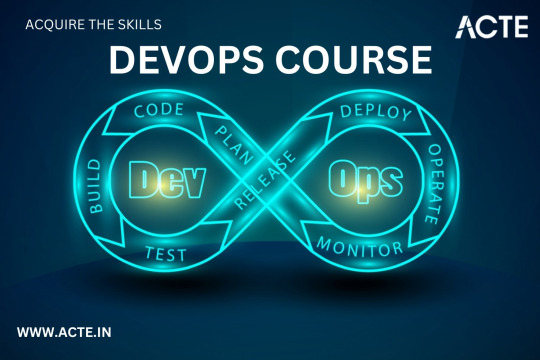
Key Components of Our DevOps Course
Our DevOps course is meticulously designed to provide you with a comprehensive understanding of the DevOps methodology and equip you with the necessary tools and techniques to excel in the field. Here are the key components you can expect to delve into during the course:
1. Understanding DevOps Fundamentals
Learn the core principles and concepts of DevOps, including continuous integration, continuous delivery, infrastructure automation, and collaboration techniques. Gain insights into how DevOps practices can enhance software development efficiency and communication within cross-functional teams.
2. Mastering Cloud Computing Technologies
Immerse yourself in cloud computing platforms like Amazon Web Services (AWS), Microsoft Azure, and Google Cloud Platform. Acquire hands-on experience in deploying applications, managing serverless architectures, and leveraging containerization technologies such as Docker and Kubernetes for scalable and efficient deployment.
3. Automating Infrastructure as Code
Discover the power of infrastructure automation through tools like Ansible, Terraform, and Puppet. Automate the provisioning, configuration, and management of infrastructure resources, enabling rapid scalability, agility, and error-free deployments.
4. Monitoring and Performance Optimization
Explore various monitoring and observability tools, including Elasticsearch, Grafana, and Prometheus, to ensure your applications are running smoothly and performing optimally. Learn how to diagnose and resolve performance bottlenecks, conduct efficient log analysis, and implement effective alerting mechanisms.
5. Embracing Continuous Integration and Delivery
Dive into the world of continuous integration and delivery (CI/CD) pipelines using popular tools like Jenkins, GitLab CI/CD, and CircleCI. Gain a deep understanding of how to automate build processes, run tests, and deploy applications seamlessly to achieve faster and more reliable software releases.
Reasons to Choose Our DevOps Course
There are numerous reasons why our DevOps course stands out from the rest. Here are some compelling factors that make it the ideal choice for aspiring software developers:
Expert Instructors: Learn from industry professionals who possess extensive experience in the field of DevOps and have a genuine passion for teaching. Benefit from their wealth of knowledge and practical insights gained from working on real-world projects.
Hands-On Approach: Our course emphasizes hands-on learning to ensure you develop the practical skills necessary to thrive in a DevOps environment. Through immersive lab sessions, you will have opportunities to apply the concepts learned and gain valuable experience working with industry-standard tools and technologies.
Tailored Curriculum: We understand that every learner is unique, so our curriculum is strategically designed to cater to individuals of varying proficiency levels. Whether you are a beginner or an experienced professional, our course will be tailored to suit your needs and help you achieve your desired goals.
Industry-Relevant Projects: Gain practical exposure to real-world scenarios by working on industry-relevant projects. Apply your newly acquired skills to solve complex problems and build innovative solutions that mirror the challenges faced by DevOps practitioners in the industry today.
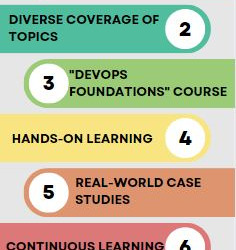
Benefits of Joining Our DevOps Course
By joining our DevOps course, you open up a world of benefits that will enhance your software development career. Here are some notable advantages you can expect to gain:
Enhanced Employability: Acquire sought-after skills that are in high demand in the software development industry. Stand out from the crowd and increase your employability prospects by showcasing your proficiency in DevOps methodologies and tools.
Higher Earning Potential: With the rise of DevOps practices, organizations are willing to offer competitive remuneration packages to skilled professionals. By mastering DevOps through our course, you can significantly increase your earning potential in the tech industry.
Streamlined Software Development Processes: Gain the ability to streamline software development workflows by effectively integrating development and operations. With DevOps expertise, you will be capable of accelerating software deployment, reducing errors, and improving the overall efficiency of the development lifecycle.
Continuous Learning and Growth: DevOps is a rapidly evolving field, and by joining our course, you become a part of a community committed to continuous learning and growth. Stay updated with the latest industry trends, technologies, and best practices to ensure your skills remain relevant in an ever-changing tech landscape.
In conclusion, our unique DevOps course at ACTE institute offers unparalleled opportunities for software developers to level up their skills and propel their careers forward. With a comprehensive curriculum, remarkable placement opportunities, and a host of benefits, joining our course is undoubtedly a wise investment in your future success. Don't miss out on this incredible chance to become a proficient DevOps practitioner and unlock new horizons in the world of software development. Enroll today and embark on an exciting journey towards professional growth and achievement!
10 notes
·
View notes
Text
Project Success: Managing with PRINCE2 Agile Practitioner
Introduction:
In the ever-evolving landscape of project management, staying agile and adaptable is key to achieving success. One methodology that seamlessly blends the structure of PRINCE2 with the flexibility of Agile is the PRINCE2 Agile Practitioner approach. In this blog, we will explore the fundamentals of PRINCE2 Agile Practitioner and understand how it can enhance project outcomes.
Understanding PRINCE2 Agile:
PRINCE2 (PRojects IN Controlled Environments) has long been a go-to framework for project management, providing a structured and systematic approach. On the other hand, Agile methodologies prioritize flexibility, collaboration, and iterative development. PRINCE2 Agile Practitioner brings these two worlds together, creating a powerful synergy that addresses the challenges faced by project managers in dynamic environments.
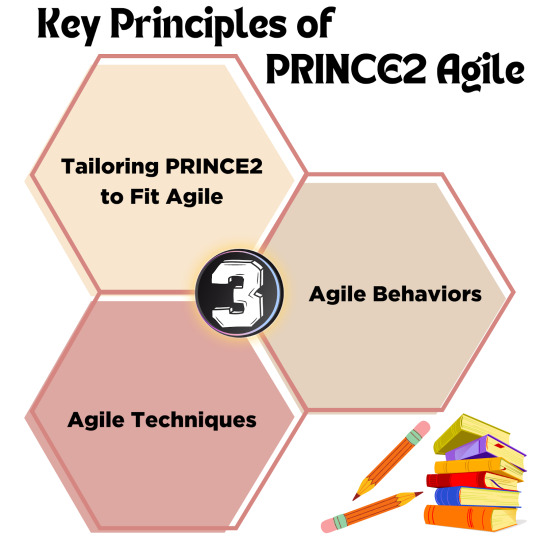
Key Principles of PRINCE2 Agile:
1. Tailoring PRINCE2 to Fit Agile:
PRINCE2 Agile Practitioner allows for tailoring traditional PRINCE2 processes to accommodate Agile practices. This ensures that the methodology is not overly prescriptive, providing room for Agile teams to thrive.
2. Agile Behaviors:
The framework promotes the adoption of key Agile behaviors, such as transparency, collaboration, and frequent feedback. This helps in fostering a culture that values adaptability and embraces change.
3. Agile Techniques:
PRINCE2 Agile Practitioner introduces a range of Agile techniques, including Scrum, Kanban, and Lean Startup, among others. This allows project managers to select the techniques that best suit the project's context and requirements.
Benefits of PRINCE2 Agile Practitioner:
1. Enhanced Flexibility:
The combination of PRINCE2 and Agile provides a structured approach while allowing for flexibility in adapting to changing project dynamics. This ensures that projects can evolve in response to customer needs and market trends.
2. Improved Communication and Collaboration:
The Agile emphasis on communication and collaboration is integrated into PRINCE2 Agile, fostering a more engaged and transparent project environment. This leads to better team cohesion and improved decision-making processes.
3. Reduced Risk:
By incorporating Agile techniques for risk management, such as early and frequent testing, PRINCE2 Agile Practitioner helps identify and mitigate risks proactively. This ultimately minimizes the chances of project failure.
4. Continuous Improvement:
PRINCE2 Agile Practitioner encourages a mindset of continuous improvement through regular retrospectives and feedback loops. This iterative approach ensures that lessons learned are incorporated into future project phases, enhancing overall project performance.
Conclusion:
In the fast-paced world of project management, the PRINCE2 Agile Practitioner approach stands out as a versatile and effective methodology. By combining the best of both PRINCE2 and Agile, this framework empowers project managers to navigate complexity, respond to change, and deliver successful outcomes. As organizations increasingly seek adaptable and responsive project management approaches, the PRINCE2 Agile Practitioner emerges as a valuable tool for achieving project success.
3 notes
·
View notes
Text
Enigma: Unpacking the Complexity of AWS Certified Solutions Architect - Associate Examination
Embarking on the odyssey toward achieving AWS Certified Solutions Architect - Associate accreditation brings with it a blend of anticipation and enthusiasm. Frequently, the discussion revolves around the perceived difficulty of the exam, and comprehending its intricacies is pivotal in devising a comprehensive preparation strategy. Let's delve into the layers of complexity that define the AWS Certified Solutions Architect - Associate examination.
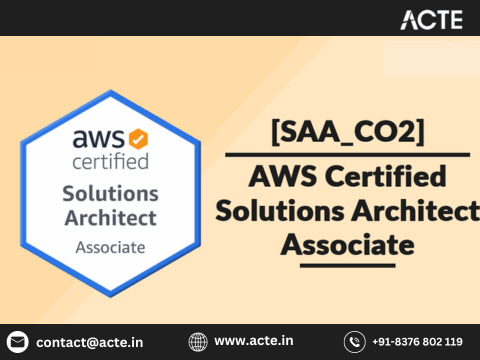
1. Fundamental Mastery as the Cornerstone: At the heart of the exam lies the imperative for a sturdy foundation. Your adeptness in AWS services, application of architectural best practices, and proficiency in crafting solutions aligned with customer needs serve as the cornerstone. This surpasses mere theoretical understanding, necessitating hands-on experience and an intimate acquaintance with AWS services.
2. The Mosaic of Exam Structure: The exam's architecture contributes to its intricate nature. Comprising an amalgamation of multiple-choice and scenario-based questions, it spans a diverse array of topics, encompassing compute, storage, security, and networking. Familiarizing yourself with various question formats through practice exams and immersive hands-on labs is instrumental in fortifying your preparation.
3. Bridging the Gap: From Theory to Application: What elevates this exam is its emphasis on real-world application. It transcends the boundaries of rote memorization, challenging candidates to apply their knowledge across varied scenarios. Practical experience in designing solutions on AWS emerges as a valuable asset, empowering candidates to navigate scenario-based questions with poise.
4. Preparation: A Defining Element: Thorough preparation emerges as the linchpin for success. AWS extends an official exam guide outlining the covered topics. Beyond this, delving into the expanse of AWS documentation, whitepapers, and enrolling in online courses enriches the knowledge spectrum. Hands-on experience, gained through labs and project engagements, not only deepens understanding but readies candidates for the practical demands of the exam.
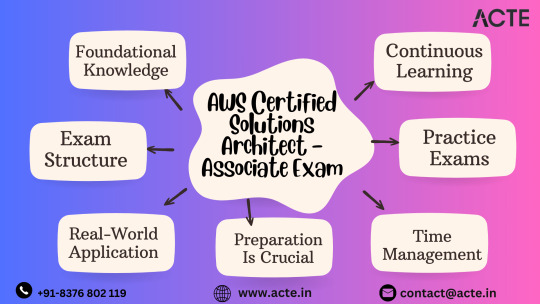
5. The Choreography of Time Management: Strategic time management during the exam becomes a ballet of sorts, demanding precision. Some questions may demand a more intricate dance with time than others. Practice exams metamorphose into a rehearsal stage, refining the skill of allocating time judiciously to ensure that all questions receive due attention within the allocated timeframe.
6. The Pivotal Role of Practice Exams: Engaging with practice exams isn't merely a suggestion but a tactical move. It acquaints candidates with diverse question formats, serves as a litmus test for readiness, and acts as a compass, pointing to areas that necessitate further honing. Consider practice exams as a diagnostic tool, sculpting your study plan based on identified strengths and areas demanding reinforcement.
7. Embracing a Culture of Continuous Learning: The AWS ecosystem evolves, and the exam content metamorphoses in tandem. Keeping abreast of AWS updates, assimilating knowledge of new features, and adopting industry best practices becomes more than advantageous—it evolves into a culture of perpetual learning, enhancing the overall competency of candidates. This not only propels exam success but positions candidates as agile Solutions Architects.
In conclusion, while the AWS Certified Solutions Architect - Associate exam poses challenges, a strategic and immersive preparation approach renders it navigable. Success pivots on a robust foundation, practical experience, meticulous preparation, and an unwavering commitment to continuous learning. Approach the exam as a transformative journey that hones your skills, establishing you as an adept Solutions Architect in the dynamic AWS domain. Embrace the challenge, and let your preparation be the guiding star leading you to triumph.
2 notes
·
View notes
Text
Unlocking Success: Digital Transformation Strategies for Modern Businesses
In an age where digital technology is reshaping industries and customer expectations, businesses are continually challenged to adapt or risk falling behind. This phenomenon has given birth to a buzzword in corporate boardrooms and IT Companies alike: Digital Transformation.

Digital Transformation isn't just about adopting the latest technology trends; it's a holistic approach to fundamentally altering how a business operates and delivers value to its customers. To succeed in this ever-evolving landscape, organizations must develop effective strategies. In this blog, we'll explore the essence of Digital Transformation and provide actionable strategies for your business.
Understanding Digital Transformation
Digital Transformation is the integration of digital technology into all areas of a business, fundamentally changing how it operates and delivers value to customers. It's not a one-size-fits-all process; it varies depending on an organization's unique goals, industry, and starting point. Here are some key elements to understand:
1. Customer-Centric Approach: At the heart of Digital Transformation is a focus on meeting customer needs and expectations more effectively. This involves leveraging technology to enhance customer experiences and gain insights into their preferences.
2. Data-Driven Decision Making: Collecting and analyzing data is critical for making informed decisions. Digital Transformation often involves implementing robust data analytics and business intelligence tools.
3. Process Optimization: Streamlining and automating processes can significantly increase efficiency and reduce costs. This often includes the adoption of workflow automation tools and customer relationship management software (CRM).
4. Cultural Shift: Changing the organization's culture to be more agile, innovative, and open to technology-driven changes is vital. This requires strong leadership and employee buy-in.
Strategies for Digital Transformation Success
1. Define Clear Objectives: Start by setting specific, measurable, and achievable goals for your Digital Transformation. Understand why you are embarking on this journey and what outcomes you hope to achieve.
2. Customer-Centricity: Understand your customers' needs and preferences through data analysis and feedback. Tailor your products, services, and interactions accordingly.
3. Data-Driven Insights: Invest in robust data analytics tools to gain actionable insights from your data. Use these insights to make informed decisions and create personalized customer experiences.
4. Agile Methodologies: Adopt agile project management methodologies to increase flexibility and adaptability in your organization. This allows you to respond quickly to changing market conditions and customer demands.
5. Innovation Culture: Encourage a culture of innovation by fostering collaboration and experimentation. Provide employees with the tools and resources to innovate and stay ahead of the competition.
6. Cybersecurity and Compliance: Ensure that your Digital Transformation initiatives include robust cybersecurity measures and compliance with relevant regulations, protecting both your data and your customers' data.
7. Talent Development: Invest in training and upskilling your workforce to equip them with the skills needed for the digital age. This includes technology training, data literacy, and digital marketing skills.
8. Partnerships and Ecosystems: Collaborate with technology partners and participate in industry ecosystems to access expertise and stay current with the latest technological advancements.
9. Continuous Improvement: Digital Transformation is an ongoing process. Regularly assess your progress, gather feedback, and adjust your strategies to stay relevant and competitive.
10. Leadership Commitment: Finally, strong leadership commitment is essential. Leaders should champion the Digital Transformation journey and lead by example.
Digital Transformation is not just a trend; it's a necessity for businesses to thrive in the digital age. To succeed, organizations must embrace change, put the customer at the centre of their strategies, and leverage technology effectively. With a well-defined strategy and commitment to continuous improvement, your business can navigate the evolving landscape and unlock new opportunities for growth and innovation in the digital era.
3 notes
·
View notes
Text
Sudarshan Pharma Embarks on Global Expansion with New U.S. Subsidiary
In a decisive step towards international expansion, Sudarshan Pharma Industries Limited has announced its intention to incorporate a wholly owned subsidiary in the United States of America. The Board of Directors has approved the proposal, and the new entity is expected to be named Sudarshan Industries LLC, subject to final approval by the appropriate regulatory authorities in the U.S.
This move marks a significant milestone in Sudarshan Pharma’s strategic roadmap, as the company positions itself to establish a direct presence in one of the world’s most influential pharmaceutical and chemical markets. By incorporating a subsidiary in the U.S., the company not only gains access to an advanced regulatory ecosystem but also strengthens its foothold in the global supply chain for pharmaceutical, chemical, and fast-moving consumer goods (FMCG).
According to the disclosure submitted to the Bombay Stock Exchange (BSE) on June 19, 2025, the newly proposed entity will fall fully under Sudarshan Pharma’s ownership, ensuring complete strategic and operational control from inception. The decision to establish Sudarshan Industries LLC aligns with the company’s core business — manufacturing and trading in pharmaceutical and chemical products — and extends its capacity to serve international demand, particularly in North America.
While this incorporation does not fall under a related party transaction and does not involve any share swaps or mergers, it carries significant implications for the company’s international strategy. With a 100% equity stake in the U.S. subsidiary, Sudarshan Pharma aims to leverage this extension to streamline operations, engage with new clients, and eventually localize certain manufacturing and distribution activities to meet market-specific needs more efficiently.
In terms of regulatory compliance, the company has acknowledged the need for approval from the Reserve Bank of India under the Foreign Exchange Management Act (FEMA), 1999, particularly under the updated Overseas Investment Rules and Regulations of 2022. Given the nature of the expansion, the company has indicated that these approvals fall within the automatic route, which should enable a smooth and timely incorporation process. The indicative timeline for completing the registration and operational readiness of the subsidiary is projected to be around six months.
Although specific financial commitments or valuation figures have not been disclosed at this stage, what remains clear is the scale of intent. Sudarshan Pharma is making this move not just to widen its market reach but to fundamentally shift how it engages with its global clientele. With no historical turnover or operational data to share just yet, the subsidiary represents a blank slate — one that the parent company is eager to shape with its decades of expertise in pharmaceutical and chemical development.
Sachin Mehta, Joint Managing Director of Sudarshan Pharma, emphasized the broader significance of this expansion. Establishing a base in the U.S. not only enhances the company's visibility in a critical global market but also allows for deeper engagement in cross-border trade, compliance, and innovation. This move reinforces Sudarshan Pharma’s mission to provide world-class products, manufactured and marketed through modern, sustainable business practices.
Founded with a vision to make pharmaceutical and chemical solutions more accessible and affordable, Sudarshan Pharma has steadily built its brand on quality, trust, and innovation. With a robust presence in India and an ever-expanding product portfolio, the company has served diverse sectors ranging from pharmaceuticals to FMCG, offering smart solutions tailored to evolving customer needs.
As Sudarshan Industries LLC comes into being, it symbolizes a pivotal chapter in the company’s growth narrative — a chapter that reflects both ambition and agility. It is not merely about geographical diversification, but about becoming a more integrated, forward-thinking, and globally connected enterprise. The journey ahead in the United States promises opportunities for new partnerships, deeper R&D engagements, and a faster response to global demand for specialized chemical and pharmaceutical products.
With this strategic move, Sudarshan Pharma Industries Limited takes a definitive leap onto the global stage — reaffirming its commitment to innovation, excellence, and long-term stakeholder value.
0 notes
Text
Unlocking Potential: A Guide to Agile Fundamentals by Coach2Reach Canada
Coach2Reach Canada offers a comprehensive guide to understanding and implementing the key concepts of agile software development, allowing professionals to unlock their potential and maximize success in project management. This guide provides an overview of the essential elements of agile fundamentals methodology including Scrum, Kanban, Lean, XP, TDD, BDD and DevOps frameworks. It also provides guidance on how to integrate these various frameworks into a cohesive development process that is tailored to each individual business' requirements. Additionally, Coach2Reach Canada's curriculum covers topics related to team dynamics such as effective communication techniques and collaboration tools that support successful teams.

The course materials are delivered through interactive webinars with experienced coaches who provide personalized feedback and best practices for applying Agile principles in the workplace environment. The coaches provide hands-on exercises which allow participants to test their understanding of the fundamentals while receiving real-time feedback from experts. Furthermore, individuals have access to a private community forum where they can connect with peers and mentors in order to gain further insight into Agile principles.
Finally, participants who complete the course will receive certification from Coach2Reach Canada confirming their mastery of Agile fundamentals enabling them to become more effective practitioners in their chosen field. The certification is recognized by industry leading organizations around the world as evidence of professional growth through Agile methodology training.
Courses we offer:ICP ACC Agile Coaching, ICP ATF – Agile Team Facilitation, ICP BAF – Business Agility Foundations, ICP CAT – Coaching Agile Transformations, ICP ENT – Enterprise Agile Coaching, TBR – Training from the Back of the Room, Agile Fundamentals Certification, Core Coaching Competencies
#agile fundamentals#agile fundamentals certification#agile fundamentals including scrum and kanban#agile fundamentals training#agile project management fundamentals
0 notes
Text

Top Institute for Scrum Master Certification in Chennai
If you’re ready to step into a rewarding Agile career, choosing the best institute for Scrum Master certification in Chennai is your first and most important move.Scrum Masters are in greater demand across a range of industries, including IT, banking, healthcare, and e-commerce. With Agile teams becoming the norm, organizations need professionals who can facilitate collaboration, remove blockers, and drive projects toward meaningful results.
This blog will walk you through why certification is important, the process of starting Agile training, and why Skill Yantra stands at the top if success is what you are looking for. Whether you are a beginner learning the fundamentals of Jira or looking for a SAFe Scrum Master certification, we have you covered.
Why Scrum Master Certification Is Important in the Current Job Market
Scrum is no longer a buzz term—it's an established framework that dictates how teams rapidly deliver value. Your certified Scrum Master is not a mere project coordinator. They are change leaders aware of Agile principles, coordinate sprints, handle team dynamics, and increase continuous improvement.
Certification not only indicates that you are interested, but it also signifies commitment and capabilities.
And as far as how to locate the best institute for Scrum Master certification in Chennai location is secondary to quality. That's where Skill Yantra excels.
Begin with the Fundamentals: Agile Course & Jira
Before you jump into certification, you need a strong foundation in Agile training. Agile is a philosophy—a move away from strict planning toward adaptable collaboration. You study frameworks such as Scrum, Kanban, and SAFe. You learn about concepts such as sprints, user stories, product backlog, and retrospectives.
Agile is not sufficient on its own, though. Tools are important too.
This is why it is strongly suggested that you learn Jira fundamentals. Jira is among the most popular tools for Agile project management. Whether you're monitoring epics and stories or conducting sprint planning sessions, learning Jira skills makes you employable.
Most leading recruiters actively seek candidates who can utilize Jira, so this is a must-have for your Agile arsenal.
What Is SAFe Scrum Master Certification?
If you aspire to work in large corporations or organizations which scale Agile for more than one or two teams, the SAFe Scrum Master certification will prove to be a game-changer. In contrast to simple Scrum, SAFe (Scaled Agile Framework) is for enterprise-level projects having various cross-functional teams collaborating.
SAFe-certified Scrum Masters see the larger picture. They drive Agile across teams, coordinate delivery with business objectives, and make sure that there is communication across all levels of the company.
Skill Yantra provides exclusive coaching in SAFe Scrum Master certification that enables you to make the transition from team-level Agile to enterprise leadership.
Why Chennai's Top Scrum Master Certification Institute Is Skill Yantra
So why is Skill Yantra widely regarded as the best institute for Scrum Master certification in Chennai ?
Here’s what sets it apart:
Certified Trainers with Real-World Experience
Learn from professionals who have worked in Agile transformations across global companies.
Hands-On Learning
Jira basics, will expose you to real-world use cases, such as backlog refining and sprint simulations.
SAFe Certification Preparation
comprehensive instruction and practice exams to get ready for the SAFe Scrum Master certification test..
Job Assistance & Placement Support
Skill Yantra's team provides resume creation, interview preparation, and placement in leading companies.
Online & Offline Learning Options
You're a working professional or a fresh graduate, flexible timing won't let you miss out.
Recognition Across Industries
Skill Yantra is respected by the hiring managers and HR teams seeking certified Agile professionals in Chennai and across the world.
Real Career Benefits of a Scrum Master Certification
When you become certified from the premier institute for best institute for Scrum Master certification in Chennai such as Skill Yantra, your resume shines. Here's why:
Improved Job Opportunities: Leading MNCs prefer certified professionals.
Greater Pay Packages: Certifications can mean a 20-30% pay increase.
Career Change Ready: From programmer to Scrum Master or business analyst to Agile coach.
Leadership Roles in Teams: Certified Scrum Masters tend to transition to leadership sooner than non-certified colleagues.
And with intensive Agile training and hands-on practice working with Jira basics, you're a complete professional.
What You'll Learn at Skill Yantra
At Skill Yantra, becoming a certified professional from a beginner involves:
Agile & Scrum basics
Sprint planning and review methods
Product backlog handling
Working with Agile tools such as Jira basics and Confluence
SAFe Scrum Master certification preparation
Soft skills: servant leadership, facilitation, conflict management
And, Skill Yantra has mini-projects, live situations, and simulation labs to provide you with hands-on experience.
What Past Students Have to Say
"I came to Skill Yantra with no Agile experience. Within four weeks, I had learned from Jira fundamentals to SAFe framework. I passed my exam in my first attempt and got placed in an MNC!" – Meena R., Scrum Master, Chennai
"Must say the best institute to get Scrum Master certified in Chennai. Trainers are helpful, and placement team is excellent." – Rajeev T., Agile Coach
Conclusion: The Right Training Can Change Your Career
Your path to Scrum Master success begins with intelligent decisions. If you're reinforcing Jira fundamentals, getting Agile training, or looking for a SAFe Scrum Master certification, one choice is most important—where you take it.
Selecting the right institute for Scrum Master certification in Chennai is not a matter of hype—it's a matter of results, actual learning, and career change.
And that's why Skill Yantra remains the first choice for every aspiring Scrum Master.
Invest in your self. Learn Agile the right way. Begin your journey with Skill Yantra today.
+91-90361 53201
0 notes
Text
What to Expect from Top QA Software Testing Courses?
In the dynamic and rapidly evolving IT landscape, Quality Assurance (QA) software testing has emerged as a crucial discipline that ensures software products meet the highest standards before they reach end users. The role of a QA tester is integral to any software development lifecycle, making QA professionals highly sought after. However, with numerous QA software testing courses available, knowing exactly what to expect from top-tier courses can be a daunting task.
This comprehensive guide sheds light on the essential elements you should anticipate from premier QA software testing courses, ensuring you gain maximum value and set yourself up for career success.
Comprehensive Curriculum Covering Fundamental Concepts
Top QA software testing courses provide a detailed curriculum covering the core concepts of software testing, equipping learners with foundational knowledge. Expect to delve into topics such as:
Software Testing Basics: Understanding the principles, concepts, and importance of software testing.
Types of Testing: Explorations into manual testing, automated testing, functional and non-functional testing, regression testing, usability testing, and performance testing.
Software Development Life Cycle (SDLC) and Software Testing Life Cycle (STLC): Deep dive into methodologies including Agile, Scrum, Waterfall, and their relation to QA.
Defect Life Cycle Management: Learning to track, document, and manage software defects effectively.
A well-rounded course ensures you grasp not just theoretical knowledge but also how to practically apply these fundamentals in real-world scenarios.
Extensive Hands-On Experience and Real-World Projects
Expect to engage in extensive hands-on projects when enrolling in a quality QA software testing course. Practical application of concepts learned in the classroom is critical. Courses often include:
Project-Based Assignments: These involve working on actual software applications, conducting tests, and reporting bugs.
Interactive Labs: Use of industry-standard tools in simulated environments to replicate real-world QA testing scenarios.
Capstone Projects: Large-scale projects designed to showcase your cumulative learning, often mirroring real industry challenges.
Such hands-on experiences solidify theoretical concepts and enhance practical problem-solving skills, making you job-ready upon course completion.
Proficiency in Industry-Leading QA Testing Tools
Top QA courses will familiarize you with the latest and most widely used software testing tools. These tools help automate, streamline, and efficiently execute QA processes. Expect to gain proficiency in tools such as:
Selenium: For automated web browser testing.
JIRA: To manage test cases and defect tracking.
TestRail: For comprehensive test management.
JMeter and LoadRunner: For performance testing.
Postman: For API testing.
Mastering these tools ensures you're not only aware of the industry's best practices but also competent in executing them effectively in professional settings.
Expert Instruction from Industry Professionals
Top QA software testing courses are often distinguished by their instructors. Expect your training to be delivered by experienced professionals who:
Hold substantial real-world QA industry experience.
Have worked on diverse and complex projects.
Understand current market demands and the latest trends.
Provide practical tips and career guidance based on first-hand experiences.
Such mentorship helps bridge the gap between theoretical knowledge and industry expectations, offering invaluable insights for career advancement.
Robust Course Structure and Clear Learning Outcomes
Premier QA courses offer clear and organized curricula with structured modules, each targeting specific learning outcomes. Expect:
Clearly Defined Goals: Each course segment should outline precisely what knowledge and skills you will acquire.
Regular Assessments: Quizzes, assignments, and periodic tests to measure your progress.
Interactive Learning: Opportunities to engage in group discussions, forums, and collaborative exercises to reinforce learning.
This organized approach ensures consistent progress and clarity about your skill development throughout the course.
Preparation for Industry Certifications
Many top-tier QA software testing courses align their content with industry-recognized certifications, such as:
ISTQB (International Software Testing Qualifications Board)
Certified Software Tester (CSTE)
Certified Associate in Software Testing (CAST)
Expect dedicated sessions or modules that specifically prepare you for these examinations, greatly enhancing your professional credibility and employability.
Flexible Learning Formats
Recognizing diverse learner needs, top courses offer various formats such as:
Online and In-Person Options: Catering to those preferring either face-to-face interaction or flexible, remote learning.
Part-time and Full-time Scheduling: Allowing you to choose courses that fit your lifestyle, whether you're a working professional or a full-time learner.
Flexibility ensures that learning is accessible, regardless of your personal circumstances or professional commitments.
Personalized Career Support and Job Placement Assistance
Top courses go beyond teaching; they actively assist you in career development. Expect support including:
Resume Preparation: Personalized guidance on crafting professional resumes tailored specifically for QA roles.
Interview Training: Sessions on mastering QA job interviews, focusing on both technical and behavioral aspects.
Job Placement Assistance: Connections to internships, entry-level positions, and networking opportunities within the QA testing industry.
This holistic support significantly improves your chances of landing a desirable job in QA testing.
Strong Community and Networking Opportunities
Enrollment in reputable Quality assurance courses online often grants you access to vibrant communities. Expect:
Alumni Networks: Active alumni communities provide mentorship and share job opportunities.
Industry Connections: Networking events, webinars, and workshops that introduce you to industry leaders.
Peer Learning: Opportunities to collaborate with classmates on projects, discuss industry trends, and build long-lasting professional relationships.
These networks can open doors to numerous career opportunities and continual professional growth.
Continuous Learning Resources and Lifetime Access
Top courses provide access to ongoing resources, even post-completion. This usually includes:
Resource Libraries: Access to up-to-date materials, case studies, and the latest research.
Refresher Content: Availability of refresher courses or updated modules to ensure your skills stay relevant as the industry evolves.
Community Forums: Continuous engagement through forums and discussion boards for lifelong learning and skill enhancement.
Such resources ensure your skills remain sharp, relevant, and aligned with market needs.
Conclusion
Enrolling in a top QA software testing course offers a comprehensive, structured, and highly practical learning experience. By expecting and selecting courses that include a robust curriculum, hands-on projects, professional tools proficiency, industry expert instruction, certification preparation, flexible learning, personalized career assistance, strong community engagement, and continuous learning resources, you set yourself on a clear path to a successful and rewarding career in QA software testing.
Investing in your education through a reputable QA testing course can indeed be transformative, elevating your professional capabilities and opening doors to endless career opportunities in the dynamic world of software development.
0 notes
Text
What is a QA Software Testing Course, and Why is it Important in Today’s Tech Industry?
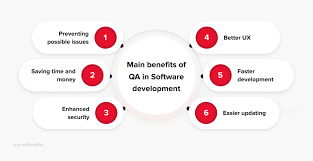
Introduction
Imagine launching a new app, only to find users abandoning it due to bugs and glitches. In the fast-paced tech world, such failures can cost companies millions. That’s where QA (Quality Assurance) software testing comes in. A QA software testing course teaches learners how to ensure digital products function smoothly, meet customer expectations, and maintain brand credibility. Today, businesses can't afford to release faulty products. The demand for skilled QA professionals is growing across sectors. Quality assurance testing courses are designed to equip learners with practical skills to meet this demand. Whether you're new to tech or switching careers, enrolling in a QA Testing Online Training Course can open doors to a stable and high-paying job in the IT industry.
What is a QA Software Testing Course?
A QA software testing course is a structured program that trains individuals to test software applications to ensure they are bug-free, functional, and meet user requirements. It typically includes both manual and automated testing techniques.
Key Concepts Covered
Software Development Life Cycle (SDLC)
Software Testing Life Cycle (STLC)
Manual Testing Basics
Automation Testing (using tools like Selenium, QTP)
Defect Tracking and Reporting
Agile and DevOps Methodologies
Test Planning and Documentation
Why is QA Testing Important in the Tech Industry?
1. Quality Control Saves Money
According to the Consortium for IT Software Quality, poor software quality costs the U.S. economy over $2 trillion annually. QA testers prevent such losses by identifying issues early.
2. User Experience Matters
A broken app leads to bad reviews and customer loss. QA testing ensures a seamless user experience.
3. Security Compliance
Many industries like healthcare and finance require thorough testing to comply with regulatory standards. QA testers are crucial in ensuring this.
4. Faster Time-to-Market
Automated QA processes allow developers to release updates quickly without sacrificing quality.
What You Will Learn in a QA Testing Online Training Course
1. Manual Testing Techniques
Learn to write and execute test cases, report bugs, and perform usability testing.
2. Automation Testing Tools
Master tools like Selenium, JUnit, TestNG, and Jenkins. Real-world use cases include writing test scripts and running automated regression tests.
3. Test Management Tools
Explore tools like JIRA, Bugzilla, and TestRail for project and defect tracking.
4. Agile and Scrum Frameworks
Work in sprints, participate in stand-ups, and collaborate in cross-functional teams.
5. Live Projects
Get hands-on experience with real-world scenarios, helping you build a solid portfolio.
Real-World Applications of QA Testing Skills
Software Development Companies
Tech firms rely heavily on QA testers to maintain software integrity.
Banking and Finance
Ensuring the security of financial transactions is non-negotiable. QA testers are responsible for safeguarding sensitive data.
E-Commerce
Testing ensures that checkout flows, payment gateways, and inventory systems work flawlessly.
Healthcare
Medical software must be error-free to avoid risks to patient safety. QA professionals ensure compliance with HIPAA and other standards.
Industry Demand for QA Testers
According to Glassdoor, QA Analysts earn an average salary of $75,000 annually in the U.S. A LinkedIn 2024 report listed "QA Testing" as one of the top 10 in-demand tech skills. With the increasing relevance of QA testing courses, more professionals are gaining the skills needed to meet industry standards. The U.S. Bureau of Labor Statistics predicts a 25% job growth for QA roles from 2023 to 2030, making it a promising and future-proof career path.
Course Structure: Step-by-Step Learning
Week 1-2: Fundamentals of Testing
Introduction to SDLC & STLC
Writing test cases
Week 3-4: Manual Testing Deep Dive
Exploratory Testing
Regression Testing
Week 5-6: Automation Basics
Introduction to Selenium
Writing basic scripts
Week 7-8: Advanced Automation
Framework Development
Integration with Jenkins and Git
Week 9-10: Tools and Frameworks
JIRA and Test Management
Real-time project simulation
Week 11-12: Capstone Project
Apply all skills to a live project
Get feedback from mentors
Who Should Take This Course?
Beginners in IT looking to start a tech career.
Non-tech professionals wanting to transition into QA.
Students aiming to build a strong portfolio.
Manual testers planning to upskill with automation.
Benefits of QA Testing Online Training Course
Flexibility
Learn at your pace, from anywhere, without compromising on your schedule.
Affordable
Online courses are often more cost-effective than bootcamps or college programs.
Certification
Get a shareable certificate that can boost your resume and LinkedIn profile.
Placement Assistance
Many platforms offer career support, including resume building, mock interviews, and job referrals.
Common Tools Taught in QA Testing Courses
Tool
Use Case
Selenium
Automated web testing
JIRA
Bug tracking and project management
TestNG
Test framework for Java
Postman
API testing
Jenkins
Continuous integration
Student Testimonials
"After completing my QA Testing Online Training Course, I landed a job within three months. The hands-on projects made all the difference." - Priya K., Software Tester
"I had zero coding experience. This course taught me everything step by step, from manual testing to automation." - Alex R., QA Analyst
Tips for Succeeding in QA Testing Courses
Practice writing test cases daily
Join QA forums and communities for peer support
Complete all assignments and capstone projects
Regularly update your resume with new skills
Frequently Asked Questions (FAQs)
1. Do I need a tech background to join this course?
No, many courses are beginner-friendly and start with the basics.
2. What if I miss a class?
Most QA Testing Online Training Courses offer recorded sessions.
3. Are there any prerequisites?
Basic computer skills and logical thinking are enough to get started.
4. Will I get a certificate?
Yes, most platforms offer a verifiable certificate of completion.
Key Takeaways
QA software testing is essential for delivering high-quality, reliable software.
A QA Testing Online Training Course can equip you with in-demand skills for a growing industry.
Real-world applications span healthcare, finance, retail, and beyond.
Learn tools like Selenium, JIRA, and Jenkins with step-by-step guidance.
Online training is affordable, flexible, and career-focused.
Conclusion
Mastering QA testing skills is one of the smartest career moves in today’s tech-driven job market. Whether you're just starting or aiming to switch careers, a QA Testing Online Training Course offers the tools, support, and flexibility you need to succeed. With comprehensive QA software testing courses, learners gain hands-on experience in identifying bugs, improving software quality, and understanding testing methodologies that are essential in the IT industry. These skills are not only in high demand but also open doors to a wide range of roles in software development and quality assurance.
Ready to test your future? Enroll in a QA Testing Online Training Course today and start building your dream tech career!
1 note
·
View note
Text
IT Staff Augmentation for App Development: Amplify Your Mobile & iOS Apps

In today’s competitive digital landscape, organizations need agility, expertise, and speed to succeed—especially when it comes to mobile app development. Traditional hiring processes can be slow, expensive, and inflexible. That’s where IT staff augmentation shines. Whether you're building a brand-new iOS app or scaling existing mobile solutions, a strategic IT staff augmentation approach can accelerate your roadmap and elevate your technology. In this blog, we’ll dive deep into:
What is IT staff augmentation?
Benefits for mobile and iOS app development
Key services SMTLabs offers
How to choose the right staffing augmentation partner
A roadmap for successful collaboration
1. What is IT Staff Augmentation?
1.1 Definition and Core Concept
Fundamentally, IT staff augmentation is a versatile approach to outsourcing. Businesses hire external IT experts—developers, designers, QA specialists, DevOps engineers—on a short-term or long-term basis. These professionals integrate seamlessly with your internal team, contributing directly to your project’s objectives.
This contrasts with traditional hiring: less recruiting effort, no long-term HR commitments, and faster onboarding. With staff augmentation, you get the exact expertise you need—and only for as long as you need it.
1.2 Why Staff Augmentation Matters for Software Projects
Agility: Scale up or down easily
Specialized Talent: Access to niche skillsets (e.g., Flutter, Swift, Kotlin)
Faster Time-to-Market: No lengthy hiring cycles
Cost Optimization: Pay-as-you-go model, reduced overhead
Risk Reduction: Reduce idle time and HR bottlenecks
For mobile and iOS app services , its staff augmentation company, where frameworks evolve weekly and consumer expectations rise constantly, this model is ideal.
2. Benefits of IT Staff Augmentation for App Development
2.1 On-Demand Expertise
Need a SwiftUI expert to refine your iOS UI? Need a React Native expert for cross-platform development? With staff augmentation, you can bring in the right specialist exactly when you need them. Whether it’s DevOps, QA, UI/UX, or performance tuning—you won’t waste months recruiting.
2.2 Faster Time-to-Market
Hiring through traditional channels takes weeks or months: sourcing, screening, interviewing, onboarding. Augmentation slashes that to days, enabling teams to hit sprint velocity almost instantly. This rapid deployment is crucial in industries where speed equals competitive advantage.
2.3 Flexibility & Scalability
As projects evolve, so do skill needs. Staff augmentation provides flexibility: scale your blended team up or down based on deliverables. Have a feature freeze? Scale back. Need rapid prototyping? Scale up. It’s dynamic.
2.4 Cost-Efficiency Compared to In-House Hiring
Hiring full-time devs incurs recurring salaries, benefits, office costs. External staff means no long-term HR commitments—just project-based staffing. This preserves budget agility and lets you invest in innovation, not infrastructure.
2.5 Seamless Integration
Reputable augmentation partners ensure their staff integrates smoothly: aligned sprint schedules, shared communication tools, and compliance with client-side processes (e.g., agile ceremonies). At SMTLabs, each dedicated pro becomes a natural extension of your team.
2.6 Reduced Hiring & Management Burden
Recruiting is time-consuming and fraught with uncertainty. With augmentation, the staffing provider handles vetting, compliance checks, administrative logistics—letting your internal team focus completely on delivery.
3. SMTLabs IT Staff Augmentation Services
3.1 Dedicated iOS App Developers
SMTLabs offers experienced iOS developers proficient in Swift, SwiftUI, Objective-C, and Apple’s Human Interface Guidelines. Whether prototyping a new app or optimizing performance, their experts handle:
Native iOS architecture planning
Design integration (both UI and UX)
Core Data, Realm, and CloudKit
Unit testing, UI testing, TestFlight, and App Store deployment
3.2 Cross-Platform & Hybrid Mobile Developers
Many companies seek cross-platform efficiency. SMTLabs supports:
React Native developers: for seamless, reusable code across iOS & Android
Flutter engineers: modern UI, single codebase, high performance
Kotlin Multiplatform, Xamarin, Ionic, and others
This flexibility enables you to decide based on speed, cost, and client needs—without hiring in-house for each platform.
3.3 UI/UX Design Specialists
User experience is critical for app adoption and retention. SMTLabs provides design pros who handle:
Interactive UX workflows
Mobile UI design (Figma, Sketch, XD)
Usability evaluations and A/B testing
Mobile-first UI frameworks
You can count on flawless, pixel-perfect designs that align seamlessly with both user expectations and your brand identity.
3.4 Quality Assurance Engineers
Delivering smooth user experiences requires robust QA. SMTLabs QA teams offer:
Manual and automated testing
End-to-end and regression testing
Device and OS matrix coverage
Continuous integration reporting
Their QA experts integrate into sprint cycles, helping you ship flawless builds—every time.
3.5 DevOps Engineers
Mobile app development often demands DevOps expertise—CI/CD pipelines, automated testing and deployment, cloud configuration. SMTLabs DevOps pros support:
GitHub Actions, Bitrise, Jenkins, CircleCI, and GitLab CI
App Store/Vendor deployments
App analytics, remote config, feature flags
Scalability and 24/7 support
This ensures bug-free, automated build pipelines for consistent and reliable releases.
4. IT Staff Augmentation vs. Other Models
4.1 Staff Augmentation vs. Managed Teams
Managed teams are fully outsourced squads handling your projects end-to-end. Staff augmentation, meanwhile, enhances your internal team. Pick augmentation when you need control and collaboration—opt for management when you want full turnkey help.
4.2 Staff Augmentation vs. Freelancers
Freelancers suit small-scale or one-off tasks. For enterprise-grade mobile + iOS development, you need consistency, support teams, and long-term reliability. SMTLabs ensures talent is certified, managed, and integrated—not ad hoc.
4.3 In-House vs. Staff Augmentation
In-house gives control and cohesion—yet with higher cost and hiring lag. Staff augmentation offers specialized skills, budget control, fast hiring, and flexibility. It’s often the most balanced option for project-focused app initiatives.
5. When to Choose Staff Augmentation
5.1 Project Scale-Ups & Peaks
Launching new modules or onboarding clients? Staff augmentation lets your team adapt quickly. SMTLabs experts can support sprint-ready developers or QA testers at a moment’s notice.
5.2 Short Notice Skill Gaps
Looking for assistance with setting up CI/CD pipelines or deploying your app on iOS? Staff augmentation fills these gaps fast—with specialists who deliver in days.
5.3 Tight Deadlines & Time-to-Market Pressure
When speed matters, every headcount counts. External app developers hit the ground running when every sprint determines market advantage.
5.4 Limited Internal Bandwidth
In-house teams may be overloaded with maintenance tasks, leaving no room for innovation. SMTLabs staff augmentation gives you extra capacity without expanding full-time headcount.
6. How It Works: SMTLabs Augmentation Process
6.1 Discovery & Skill Alignment
SMTLabs begins with your project briefing—scope, deliverables, tech stack, timeline. From there, they map your needs to available experts in iOS, Flutter, QA, or design.
6.2 Talent Matching and Vetting
Relevant internal candidates are sourced and vetted. We've talked about staff augmentation, but SMTLabs meticulously screens for technical fit, soft skills, and domain expertise.
6.3 Onboarding & Integration
Once approved, the augmented staff member is onboarded into your tools, sprint cycle, and processes. They’ll attend daily standups, use your repos, and fully integrate with your team.
6.4 Delivery & Sprint Cycles
The staff acts as an internal teammate—writing code, submitting pull requests, and participating in sprint / demo meetings. The goal: seamless collaboration and productivity.
6.5 Performance Management & Feedback
SMTLabs maintains your satisfaction matrix: KPIs, velocity, QA metrics. If roles evolve mid-cycle, staffing is adjusted—guaranteeing optimal fit and performance.
7. Tips for Maximizing Success
7.1 Clearly Define Roles & KPIs
Start with clarity. Ensure external dev or QA roles, responsibilities, sprint targets, and communication are clearly documented: "Emma will ramp up UI flows; Carlos will maintain 80% code coverage in QA."
7.2 Set Up Communication Channels
Use Slack/MS Teams, Zoom, Jira, Trello or your project tools. Invite augmented staff to daily standups, backlog grooming, and sprint planning—treat them as part of your internal crew.
7.3 Define Onboarding & Ramp-Up Period
Give new team members time to understand domain, codebase, and architecture. Allocate 1–2 weeks for orientation to ensure they're effective contributors.
7.4 Schedule Frequent Checkpoints
Host weekly demos and retrospectives. Consistent feedback helps maintain smooth sprint cycles and quickly uncovers any obstacles.
7.5 Empower with Access Rights & Context
Grant necessary repos, staging/UAT access, and design system libraries. Augmented staff should never feel peripheral—they should be empowered contributors.
8. Measuring Impact
8.1 Productivity Metrics
Track story points, code merges, QA velocity, and bug resolution. Compare sprints before and after augmentation to evaluate uplift.
8.2 Quality Indicators
Monitor crash analytics, customer reviews, and regression counts. A drop in production bugs often indicates quality gains.
8.3 Time-to-Market Gains
Measure release frequency. Do you ship features faster with augmented capacity? Usually yes.
8.4 ROI & Cost Savings
Calculate cost per iteration versus in-house hiring. When productivity gains outweigh costs, augmentation is delivering ROI.
9. Real-World Use Cases
9.1 Launching a 2‑Week MVP
A startup needed to build a cross-platform MVP in less than a month. Within days, SMTLabs provided two React Native developers, one QA, and one UI designer. The MVP launched on schedule—and attracted seed funding.
9.2 Adding iOS‑Exclusive Module
An enterprise mobile team was stable, but needed a Swift specialist to integrate Apple Pay and Notifications. Within a week, SMTLabs staffed a senior iOS engineer who completed integration, App Store approval, and testing—without adding headcount.
9.3 QA Surge for Production Release
Ahead of a critical release, internal testers were overwhelmed. Augmentation provided a QA mini-squad for 3 weeks, which executed testing across devices and OS versions—leading to zero P1/P2 issues post-launch.
10. Why Choose SMTLabs as Your Staff Augmentation Partner
Proven Expertise: Developers, UX designers, DevOps & QA accredited in mobile.
Rapid Matching: Talent is ready to join your team in days.
Flexible Engagements: Ramp up/down across sprints.
Process Integration: Augmented professionals use your tools and pipelines.
Delivery Accountability: Transparent KPIs and regular performance check-ins.
SMTLabs is more than a vendor—they become partners in your success.
11. Choosing an IT Staff Augmentation Company
When researching providers, consider:
Skill Breadth: Do they offer native iOS, React Native, Flutter expertise?
Country & Timezone Fit: How well can they overlap with your core hours?
Vet & Retain Model: How are candidates screened and knowledge transfer handled?
Scalability & Flexibility: Can they scale fast? Reduce quietly?
Cultural Fit & Communication: Can their staff communicate clearly with your team?
SMTLabs ticks every box—and offers a seamless experience.
12. Common Client Questions
Is this long-term or short-term only? Augmentation is scalable—hire for 2 weeks or 2 years.
How do we manage IP/security?SMTLabs fully adheres to your IP agreements, NDAs, and confidentiality protocols.
Can we replace someone mid-project? Yes—if the match isn’t ideal, SMTLabs will provide a replacement.
Where are the developers located? SMTLabs offers global talent—anywhere from Eastern Europe to North America—adjusted to your timezone and budget.
What support is included post‑handover? Most staff continue into production support, bug fixes, or performance improvements after core deliverables.
Conclusion
IT staff augmentation for mobile and iOS app development offers extreme flexibility, speed, and value. By partnering with experts like SMTLabs, businesses can tackle skill shortages, accelerate delivery, and preserve control over the development process—without HR headaches or long-term costs. Whether you're building an iPhone app, launching a cross-platform mobile solution, or scaling QA, staff augmentation transforms how you resource and deliver mobile innovation.
FAQs
Q1: What’s the difference between staff augmentation and nearshoring? Staff augmentation is engagement-focused (“add 1 iOS dev”); nearshore is geographic outsourcing to a region. SMTLabs does both—providing global talent who align timezones and cultures.
Q2: How are team members vetted? All SMTLabs professionals undergo skill tests, domain interviews, soft-skill vetting, and code reviews during onboarding.
Q3: Can augmented staff attend client sprint ceremonies? Yes—as full participants (standups, planning, retros), they’re treated as part of your internal team.
Q4: What kind of ongoing metrics are provided? Expect sprint KPIs, velocity charts, QA pass rates, and post-release bug analytics—kept transparent via regular reports.
Q5: How quickly can you add a resource? SMTLabs averages 5‑7 business days to source, vet, and onboard qualified staff for most mobile dev roles.
#it staff augmentation#it staff augmentation services#it staff augmentation company#it staff augmentation services in usa#hire software developers#hire remote developers#staffaugmentation#it staffing agency#it started as a joke#it staffing solutions
0 notes